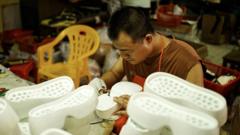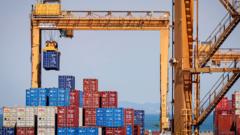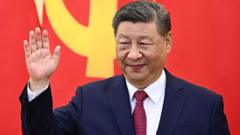Amid a rigid trade environment influenced by U.S. tariffs, small enterprises in China are grappling with halted production and dwindling prospects. Business owners express anxiety over the future, while many explore alternatives in domestic markets.
Chinese Small Businesses Struggle Amid Stalled Trade Relations

Chinese Small Businesses Struggle Amid Stalled Trade Relations
As U.S. tariffs create a tense atmosphere, small Chinese businesses face dire consequences, furthering economic challenges.
In the bustling trade hub of Guangzhou, small businesses are feeling the pinch as U.S. tariffs disrupt trade relations and choke their operations. "This is so hard for us," admits Lionel Xu, surrounded by his stagnant inventory of mosquito repellent kits, once popular on U.S. shelves. Trump's imposition of a 145% tariff on Chinese goods bound for the U.S. has left many products languishing in warehouses, prohibiting sales and reducing revenue.
A significant portion of Xu's output sells to the U.S., and as he reflects on the dire situation, worry resonates in his voice. “What if Trump doesn’t change his mind? That will be a dangerous thing for our factory,” he continues, echoing sentiments shared by countless other small business owners across the country who depend on exports.
At the annual Canton Fair, a trade event showcasing products from over 30,000 businesses, the atmosphere is thick with uncertainty. Nearby, Amy from the Guangdong Sailing Trade Company remarks, “We have stopped production already; all the products are in the warehouse.” The impact of high tariffs is evident as visitors peruse goods they may no longer afford.
Despite brief pauses in tariff increases following declines in global markets, China's economic landscape remains bleak, with both nations imposing punitive costs on one another. As tariffs continue to pose high costs, American consumer prices are likely to rise further, reflecting the challenges Brazilian consumers face in sourcing goods.
Chinese manufacturers find themselves caught between dwindling international demand and a stagnant domestic market, where consumer confidence plummets. While the nation boasts a population of 1.4 billion, the reality of a sluggish economy hampers domestic spending, leaving many factories dependent on foreign buyers.
In southern China, workers from workshops producing clothing and accessories express their disillusionment amidst the trade dispute. One sweatshop worker lamented, "I used to earn around 300 yuan a day; now it’s lucky if I get 100 yuan." With exports critical to economic growth, the trade war threatens to devastate livelihoods.
As businesses search for alternatives, many are eyeing emerging markets; Amy hopes to expand her ice cream maker sales into Europe and beyond. Others, however, remain steadfast in their products’ quality, anticipating that the tide may eventually turn. Mei Kunyan, a shoe factory owner devoted to the domestic market, insists, "The Americas are too tricky."
Despite ongoing tensions, the dialogue between Washington and Beijing seems stagnant, with little hope for resolution in the near future. Economic downturns loom on both sides, underscoring the complexities of international trade and the delicate dance of diplomacy in a globalized economy.




















